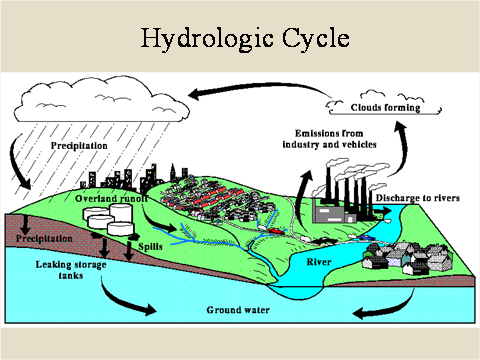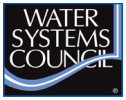The Hydrologic Cycle
The Hydrologic Cycle, or Water Cycle, illustrates the constant circulation of the earth’s water supply. The main elements that make up the cycle include: condensation, precipitation, infiltration, runoff, and evapotranspiration.

EPA Regulations
DRINKING WATER CONTAMINANTS
Most of the country receives its water from community water systems where the water quality is monitored according to the US Environmental Protection Agency. These standards, known as the National Primary Drinking Water Regulations, can be found in detail on the EPA’s website. http://water.epa.gov/drink/contaminants/index.cfm
For those who receive water from a private water supply (such as a cistern, spring, or well) the water quality is the responsibility of the homeowner. In such instances, the state and local governments may set guidelines for water safety.
Water Treatment Media
Activated Carbon
Activated Carbon is a bituminous based granular type filter material that uses the processes of adsorption and absorption to remove contaminants. Activated Carbon removes chlorine taste and other earthy odors or taste through adsorption, adhering to the carbon’s surface. Activated Carbon removes certain volatile and synthetic organic chemicals through absorption, adhering within the pore structure. The ability of Activated Carbon to both adsorb and absorb makes it one of the best filter media in the water treatment industry. The only regeneration needed is backwashing and rinsing. No chemical regenerants are required.
Birm
Birm is a granular filter media used to remove Iron and Manganese from the water supply. Birm can only be used on water with a neutral pH. We use Birm to filter out Ferric Hydroxide (precipitated) and Manganous Manganese (precipitated). We always recommend that a water softener be installed after the filter to remove any Ferrous Bicarbonate and/or Manganese that the Birm filter did not filter out.
Birm has a sacrificial coating material that acts as an insoluble catalyst to create a reaction between the dissolved oxygen and the iron and/or manganese in the water supply. This action causes the iron and/or manganese to be oxidized and then filtered out through the Birm. If any iron and/or manganese is present after the Birm filter, it will be in the Ferrous Bicarbonate and/or Manganese form and can easily be removed with a water softener. The only regeneration needed is backwashing and rinsing. No chemical regenerants are needed.
C-800
C-800 is a high capacity cation exchange resin of the sulfonated polystyrene type. C-800 is used to remove calcium and magnesium hardness, iron and manganese from the water supply. The capacity of C-800 is 30,000 grains of compensated hardness removal per cubic foot with 15 pounds of salt per regeneration.
C-800 utilizes the cation exchange process. Cation exchange means that the C-800 actually exchanges the hardness, iron and manganese in the water for sodium or potassium located on the surface of the C-800. After the pre-calculated amount of hardness, iron and manganese has entered the softener, the C-800 is regenerated with sodium or potassium chlorie which exchanges the hardness now located on the surface of the C-800.
Calcite
Calcite is a crushed and carefully screened white calcium carbonate, marble looking material that is used to increase the alkalinity, thereby increasing the pH of the water supply. Increasing the pH will eliminate the corrosiveness of the water supply.
Calcite dissolves into the water to increase the pH, but as a result also increases the hardness of the water. Because Calcite is sacrificial due to its dissolving nature, it must be added periodically. Since the Calcite filter increases hardness, a water softener is recommended.
Calcite is also an excellent material for the removal of Ferric Hydroxide (cloudy) Iron. A water softener is installed after the Calcite Filter to remove the hardness and any Ferrous Bicarbonate that the Calcite Filter missed.
The only regeneration needed is backwashing and rinsing. No chemical regenerants are needed.
Magnesium Oxide (Corosex)
Corosex is a very concentrated form of Magnesium Oxide that is always blended with calcite to reduce the risk of cementing. We call this blend of Corosex and Calcite,NS Mix. The NS Mix increases the alkalinity of the water to raise the pH value to a neutral state (7.0).
The NS Mix can raise a pH from 5.5 to 7.0 (neutral), and is recommended on any water that has a pH between 5.5 and 6.0. Corosex has the same regeneration and sacrificial properties as Calcite.
Filter Aggregate
Filter Aggregate is a lightweight granular type filer material used to remove turbidity from the water. Filter Ag can remove particles with a size as small as 20 microns.
Filter Ag is more superior than sand for sediment removal because Filter Ag is lighter in weight which requires less water for regeneration. The only regeneration needed is backwashing and rinsing. No chemical regenerants are needed.
Manganese Greensand
Manganese Greensand is a granular filter material used for the removal of Iron, Manganese and Hydrogen Sulfide. Manganese Greensand is a specific sand that is coated with a catalyst material. The Manganese Greensand uses this coating to react with iron, manganese and hydrogen sulfide in the water to create a precipitate which then is trapped in the filter media. Manganese Greensand must regenerate with Potassium Permanganate to rejuvenate the coating.
We always recommend that a water softener be installed after the filter to remove any Ferrous Bicarbonate (clear) Iron that the filter missed.
Manganese Greensand will also remove a limited amount of Hydrogen Sulfide. However, we only recommend Manganese Greensand for Hydrogen Sulfide removal on special water problems.
pH++
PH++ is a crushed and carefully screened magnesium that is used to increase the alkalinity, thereby increasing the pH of the water supply. Increasing the pH will eliminate the corrosiveness of the water supply.
PH++ is a much stronger pH corrector than NS-Mix or Calcite and should only be used if these media have failed to correct the pH. We recommend that you consult the factory for specific usage parameters.
PH++ dissolves into the water to increase the pH, but as a result also increases the hardness of the water. Because PH++ is sacrificial due to its dissolving nature, it must be added periodically. Since the PH++ filter increases hardness, a water softener is recommended.
The only regeneration needed is backwashing and rinsing. No chemical regenerants are needed.
Simplus
Simplus is a granular manganese oxide filter material used for the removal of Hydrogen Sulfide and trace levels of Iron. It can only be used on water that has a pH in the 6.8-7.8 range.
Simplus acts as a catalyst to create a reaction between dissolved oxygen and the hydrogen sulfide. We always recommend that a water softener be installed after the filter if iron or manganese is present.
Simplus can be regenerated with sodium hypochlorite (5.25% bleach) to clean precipitate from the filter material. Otherwise, regeneration included backwashing and rinsing.





